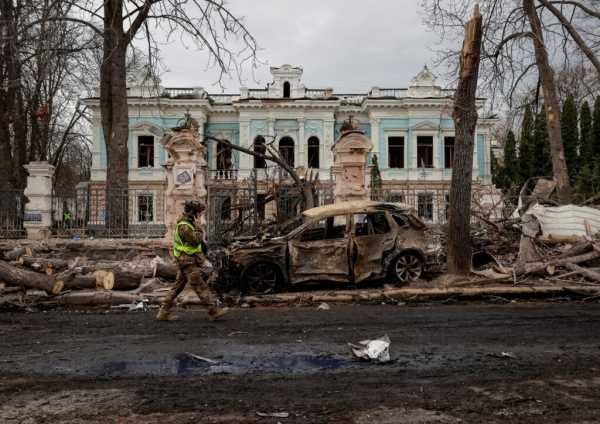
As Ukrainians headed to church on the morning of April 13 to attend Palm Sunday services, two Russian ballistic missiles struck the center of Sumy, killing at least 35 people and wounding more than 100. The Palm Sunday bombing was the deadliest Russian attack this year. It was part of an increasing recent pattern of Russian airstrikes against Ukrainian civilians that has cast doubt on the viability of U.S.-led peace talks initiated by President Trump.
The attack in Sumy came just over a week after a similarly devastating strike on a residential area in the southern Ukrainian city of Kryvyi Rih killed 19 people, including nine children. The rocket fell near a children’s playground in the early evening, when the area was crowded with children and families. According to the UN High Commissioner for Human Rights, the attack was “the deadliest single strike harming children that the Office has verified since the full-scale invasion began in February 2022.”
The Russian missile strikes on Kryvyi Rih and Sumy share a number of common features. Both attacks targeted civilian areas of major Ukrainian cities and occurred at a time when large numbers of people were likely to be present. Both attacks reportedly included cluster munitions designed to cause maximum casualties. “The use by the Russian Federation of explosive weapons with a wide area of effect in a densely populated area and without any apparent military presence demonstrates a reckless disregard for civilian life,” UN High Commissioner for Human Rights Volker Türk said after the Kryvyi Rih attack.
In addition to these ballistic missile strikes on densely populated civilian areas, Russia has also recently stepped up drone attacks across Ukraine. In the month following the first meeting between the Kremlin and White House officials in Saudi Arabia, the number of Russian drones targeting Ukraine increased by more than 50 percent. An analysis by the UK newspaper Telegraph found that Russia launched an average of 101 drones a day in the period leading up to the first February talks in Riyadh, compared with 154 afterward.
Russia’s escalating bombing of Ukraine and deadly missile attacks on Ukrainian cities are casting a long shadow over the Trump administration’s efforts to broker a peace deal and end the largest European invasion since World War II. Many see Russia’s actions as an indirect but undeniable disregard for Trump’s peacekeeping efforts. Others have also suggested that Kryvyi Rih may have been targeted because of the city’s status as the hometown of Ukrainian President Volodymyr Zelensky, to send a chilling message of Russian impunity and highlight Ukraine’s vulnerability to further such attacks.
Trump has so far refused to criticize Russia directly for the recent wave of bombings that have killed dozens of Ukrainian civilians. Instead, he has somehow concluded that the recent Palm Sunday attack in Sumy may have been a “mistake.”
Elsewhere in the U.S. and across Europe, there was widespread condemnation. “Putin’s Russia continues to bomb cities and kill civilians. It’s their strategy to wear down Ukraine. We should not accept any Ukrainian territory as a reward for these war crimes,” said Republican Representative Don Bacon. His Republican colleague Michael McCaul said the Palm Sunday attack was “beyond the pale” and further evidence that Russia has no intention of ending the war. “While Ukraine has accepted President Trump’s offer of a ceasefire, Putin continues to demonstrate that he is more interested in bloodshed than peace,” McCaul said.
Across the Atlantic, French President Emmanuel Macron responded to the Palm Sunday attack by highlighting “the flagrant disregard for human life, international law and the diplomatic efforts of President Trump.” Italian Prime Minister Giorgia Meloni echoed Macron, condemning “this unacceptable violence that runs counter to all genuine action for peace.” British Prime Minister Keir Starmer criticized Russia’s “horrible attacks” and said that while Zelensky had demonstrated his commitment to peace by backing an unconditional ceasefire, “Putin must now also agree to a full and immediate ceasefire without any conditions.”
Such calls are unlikely to find resonance in Moscow unless the entire US approach to the peace process changes significantly. Over the first few months of Trump’s peace initiative, the US has offered Russia a number of concessions, such as a ceasefire in the Black Sea , while publicly pressuring Ukraine. So far, this seems to have bolstered Putin’s belief that he can ultimately outlast the West in Ukraine. With existing US aid commitments to Ukraine set to expire in the coming months, and no sign that the Trump administration will authorize further support, it is easy to see why Putin is in no hurry to seek peace.
While Trump remains reluctant to condemn Putin, there are signs that he may finally be growing tired of the Kremlin dictator’s delaying tactics and may soon lose patience. Trump recently declared himself “very angry” and “furious” with Putin over the lack of progress toward peace, and urged him to “move” toward a ceasefire. If Trump is serious about getting Putin’s attention, he will need to follow through on his previous threats to ratchet up the economic pressure on Russia through sanctions and tariffs on Putin’s energy industry. Anything less will be interpreted by the Kremlin as a tacit green light to continue escalating attacks on Ukrainian civilians as Putin seeks to crush the country’s resistance.
Mercedes Sapuppo is Associate Director of the Atlantic Council’s Eurasia Center.
Source: Source